Views: 372
生物動力曆法﹕2022 年 10 月 11 日下午 7 時開始 – 果
用隨意行慣用的方式辦一場「布意鑒賞會」是我的七年之癢。
七年前,Dily 爲我組織了一場品布會(見:Burgundy vs Italian(中)),其後我又參加了不少酒商主辦的 Burgundy 試酒會,好幾次由 Allen Meadows 主持的大師班更令我在知識方面得益良多。不過很遺憾的是,這些試酒會不理會花果根葉,開酒也近乎即興式的,幾乎沒有一次令我滿意。
我唯有用老辦法,在家裏與太太一瓶一瓶的學,這原來是我們學意大利酒的土方法。這個方法慢,而且昂貴,不過我確信實踐出真知,我有的是能耐。
花了七年時間,我開始有些感覺了,也添了些信心,最重要的是我發現了一個極爲簡單的道理:無論什麽酒,只要有足夠内涵,慢慢的瓶醒是打開他的不二法門。經過多番嘗試,我認定 Bur 的醒酒方法與意大利酒沒兩樣,一般經過 24 小時緩慢瓶醒才能比較好的打開。
今年七月從杭州囘到香港後,我進行了謀劃已久的試驗計劃。我先後挑選了從 1985 到 2012 十多個年份,每次拿一瓶 Bur 與差不多實力的意酒作比較,全都用了 24 小時緩慢瓶醒。我們邀請了不同的朋友與我們一起品嘗,結果無一例外,朋友與侍酒師都很驚訝 Bur 不但可以開 24 小時以上,而且還會開得那麽好(見: Love in the Time of Coronavirus (27):Waltzing with Burgundy x 12)
等了七年,我終於夠膽量辦一場「布意會」了。
邀請什麽人好?
去年春天我們囘杭州前,我便邀請了一組因杭州而結緣的隨意酒友與我們一起試隆河區(見:VIPa-9 第 3 場 —- Cote Rotie and Hermitage)。他們是第一批加入隨意行隊伍的朋友當中最年輕的一群,好奇心極强,其中一位更曾主動要求我分些 Bur 給他學習用,所以就像去年一樣,今年秋天在我們離開香港重回杭州以前,我邀請了他們一伙作伴。
這晚我選的酒單如下:
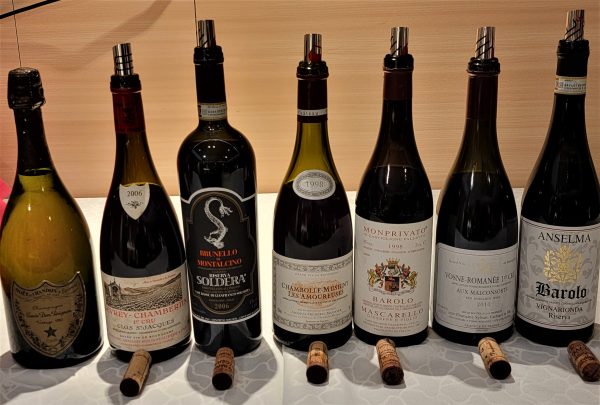
| 0. Dom Perignon, Champagne, 1985 |
| 1. Armand Rousseau, Gevrey Chambertin 1er Cru Clos St Jacques, 2006 |
| 2. Case Basse Soldera, Brunello di Montalcino Riserva, 2006 |
| 3. JF Mugnier, Chambolle Musigny Les Amoureuses Premier Cru, 1998 |
| 4. Mascarello Giuseppe, Barolo Monprivato, 1998 |
| 5. Sylvain Cathiard, Vosne Romanee 1er Cru Aux Malconsorts, 2010 |
| 6. Giacomo Anselma, Barolo Vigna Rionda Riserva, 2010 |
排列次序按 Burgundy 的地理位置從北到南走。
我選的是我最喜愛的三塊 Premier Cru 田,原因是我總覺得 Grand Cru 太不容易開了,想喝得開心,好的 Premier Cru 是不二之選。我選好了以後,才知道這三塊田也是 Jasper Morris 心目中最好的 Premier Cru,每一塊都具備 Grand Cru 實力。
與之匹配的意酒我只從 B&B 選,盡量令每對酒有可比性。有一個比較大的難題是年份,因爲同一年份在兩地往往差異甚大。我的 Burgundy 藏酒遠遠沒有意酒那麽多,所以困難更大。結果我選出來的三個年份只有 2010 讓我滿意,在兩地同樣是經典的大年份。其餘 2006 在意大利是溫暖的大年,但在 Bur 相對弱(天氣不穩定,葡萄有長霉的問題),而 1998 在 Barolo 偏暖,在 Bur 卻較多雨。不過了解和欣賞差異原來是葡萄酒帶來的最大的樂趣,就讓我們充分享受這場差異之旅吧!
除了香檳當場開以外,其餘所有酒在 24 小時前開瓶,之後拔塞作瓶醒。
開場的是先聲奪人的 0. Dom Perignon, Champagne, 1985。
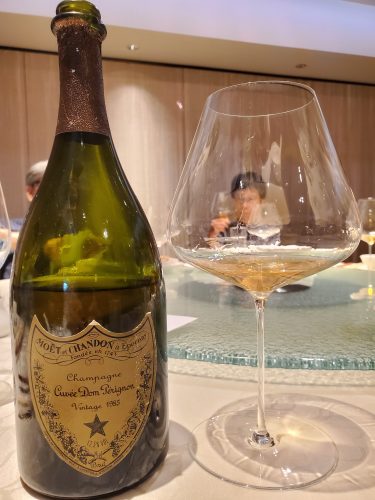 我認識不深,但覺得 Dom 是最古典味,最有 classical restraint 的香檳。這瓶 1985 差不多四十嵗了,狀態好得不得了,一點氧化的感覺都沒有,如半固態的蜂蜜漿,甜得入心入肺,帶些杏脯味,但酸度非常活潑,雖然未開盡,但太好喝了,有人奇怪沒有太多酵母的味道,我想那蜂蜜漿把什麽都吞噬了。
我認識不深,但覺得 Dom 是最古典味,最有 classical restraint 的香檳。這瓶 1985 差不多四十嵗了,狀態好得不得了,一點氧化的感覺都沒有,如半固態的蜂蜜漿,甜得入心入肺,帶些杏脯味,但酸度非常活潑,雖然未開盡,但太好喝了,有人奇怪沒有太多酵母的味道,我想那蜂蜜漿把什麽都吞噬了。
第二回合變得通透了許多,幾乎可以說優雅了,有人說喝起來似雪梨水,但難得的是既有勁度而同時又很平衡,Dom 的本色也。
我們 8 個人喝,所以我能喝到第三回合。這時有微量氧化,但絕對不是缺點,相反更添了一些風韻,所有東西都融合在一起了 — 和諧,所有酒最後都想達到卻不一定能達到的境界。
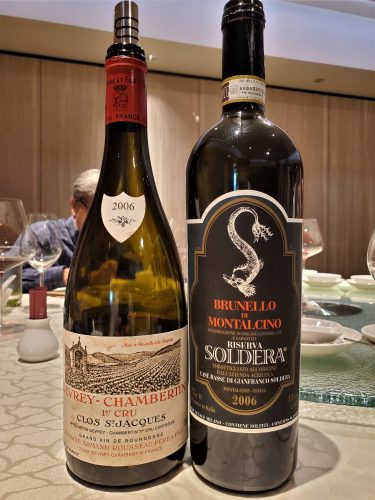 正式比試的第一雙是 1. Armand Rousseau, Gevrey Chambertin 1er Cru Clos St Jacques, 2006 對 2. Case Basse Soldera, Brunello di Montalcino Riserva, 2006。
正式比試的第一雙是 1. Armand Rousseau, Gevrey Chambertin 1er Cru Clos St Jacques, 2006 對 2. Case Basse Soldera, Brunello di Montalcino Riserva, 2006。
我在第一天的晚飯時倒了微量來試試,當時是葉日。
兩者的差別實在太大了。
1. Armand Rousseau 沾滿了泥巴,木桶味非常霸道,在杯内逐漸變得稍爲乾净一點,但木桶依然突出。
2.Case Basse Soldera 卻已經有很出色的表現 — 不錯的花香,少不了的香水,難得的輕柔和甜美,葉日下他是個淡抹的美人。
第二天晚上正式試酒的第一回合,1. Armand Rousseau 仍然是木與土的二重奏,木桶、樹林、焦土,混著明顯的丹寧,像個不修邊幅的莽張飛,不過結構感非常好,是個很地道的 Gevrey Chambertin 土著。這時最欠缺的是果,酸度因此顯得很突兀。是這年份成熟度不足,還是酒還未醒夠呢?
進入果日的 2. Case Basse Soldera 馬上換了個濃妝,施了大量香水與脂粉,不過以 Soldera 的標準屬於稍爲妖但不過分妖的一類,果與礦物味都屬於大號的,放在 1. Armand Rousseau 一旁更顯得他是個龐然大物。
我們喝得很慢,超過兩個小時以後的 1. Armand Rousseau 有如脫胎換骨一樣,花香、一點點香粉、焦土與樹皮魚貫登場,令木桶退而居配角的位置。我認識的 Armand Rousseau 是一派古典風格的,這時真人終於露相了,通透,優雅,酸度恰好。在座的所有人都很驚訝莽張飛可以搖身一變成爲美潘安!
2. Case Basse Soldera 此時越戰越勇,深色的礦物味趕上來了,把花香、香水都一一覆蓋於下,他的身體不斷在膨脹,越來越有壓迫感,幾乎沒有任何通透感可言了,酸度也感覺降低了,不過 2006 的別名是豐滿,靠近南方的 Soldera 在盛年是不可能輕盈的。
1. Armand Rousseau 的古典感,與 2. Case Basse Soldera 的爆滿感既反映了同一年份但不同氣候的天時因素,也表達了不同地塊的風味。人起作用嗎?當然有,我看兩位都是完美主義者,不過 1. Armand Rousseau 略依賴木桶來撐起酒的骨架,正如 2. Soldera 不肯用小木桶來破壞地塊本身帶來的偏重的味道。像中國山水畫裏像蒼蠅般大的人物,他們能不聼天和地的聲音嗎?
這款 1. Armand Rousseau, Gevrey Chambertin 1er Cru Clos St Jacques, 2006 到了第二回合才開得漂亮,一方面因爲這是個相對弱的年份,同時也因爲一天的瓶醒幫他預先做好了熱身;至於 2. Case Basse Soldera, Brunello di Montalcino Riserva, 2006,這麽新的年份能開到這樣已經很不錯了,真的要求 Soldera 能與 2006 Armand Rousseau 一樣開得那麽好的年份,我會選 1996。去年我做過一場 Soldera 的垂直品飲,1996 是 WOTN(見:VIPa-9 第 10 場 — Soldera Vertical)。因此選相同年份的布與意來比較貌似公平,實際上也未必。
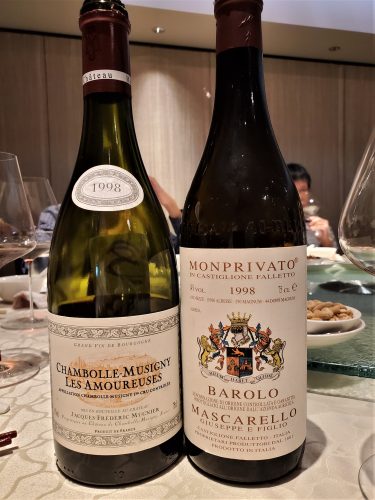 第二雙最令我期待,因爲這兩塊田最匹配。我這樣説是因爲一位資深 Bur 友在參加了我辦的一場 Monprivato 垂直品試會後告訴我 Les Amoureuses(一般稱爲愛侶田)是 Burgundy 中最近似 Monprivato 的。除了我未試過的 Georges Roumier 以外,我最喜歡 JF Mugnier 的演繹,我覺得他不造作,自然流暢,甚至可以說最有 Giacosa 的風味。
第二雙最令我期待,因爲這兩塊田最匹配。我這樣説是因爲一位資深 Bur 友在參加了我辦的一場 Monprivato 垂直品試會後告訴我 Les Amoureuses(一般稱爲愛侶田)是 Burgundy 中最近似 Monprivato 的。除了我未試過的 Georges Roumier 以外,我最喜歡 JF Mugnier 的演繹,我覺得他不造作,自然流暢,甚至可以說最有 Giacosa 的風味。
我在第一天的晚飯時分帶著緊張的心情第一次比較他們。
3. JF Mugnier, Chambolle Musigny Les Amoureuses Premier Cru, 1998 已經很精彩了 — 清香、靈巧但同時入口味道像大珠小珠落玉盤一樣,非常豐富。我用靈巧(deft),是借用了 Matt Kramer 對 Chambolle Musigny 非常言簡意賅的概括:
Chambolle-Musigny makes wines of grace … There should always be some underlying strength, even in commune-level Chambolle-Musigny. It’s too easy to confuse lightness with deftness. A good Chambolle-Musigny at whatever level should have backbone: one should be able to readily sense forceful flavor and see both structure and fruit.
[Making Sense of Burgundy, p.171]
我的筆記寫下了 “奇觀” 兩字。
4. Mascarello Giuseppe, Barolo Monprivato, 1998 一下杯便出香粉,很典型的 Monprivato。沒有比較,我會說他輕柔,但與愛侶相比,感覺他有重量,有骨架。
晚上第一回合,3. JF Mugnier, Chambolle Musigny Les Amoureuses Premier Cru, 1998 完全綻放了,那香粉有幾分 Soldera 還沒開透時的影子,不過一切都是靈巧的:花香、泥土香、碎石子混在一起,不甜也絕對不妖,最要命的是入口柔滑如絲,多曼妙的舞姿!
4. Mascarello Giuseppe, Barolo Monprivato, 1998 這時也不甘示弱,在香粉之外,多了些茶葉、樹木的很地氣的香,丹寧這時增多了,顯得有點突兀,甚至有些許凌亂的感覺,不過這也很正常,他仍然在長肌肉,今天像頭奔跑著的馬兒。
我借這個機會問了大家怎麽比較這兩款酒。
有為愛侶叫好的:
- 驚艷
- 更香,更好喝,連我這個意大利鐵粉也不會抗拒,這種 Bur 完全可以接受
也當然有維護意大利的:
- Monprivato 實在
- 愛侶開得足夠,表現力好,但沒有太大變化;Monprivato 不斷的變化,更吸引我
- Monprivato 無論結構與複雜度都更好,這款 Burgundy 我未喝過,但開得很好,現在很好喝
- Monprivato 更實在
我得說我全票投了給這款 3. JF Mugnier 的愛侶,就爲了他的 Giacosa 氣質。還有一點令他在我心中成爲 Burgundy 的典範:他是名莊中最不依靠木桶的(另一位可能是 Michel Lafarge),也因此我在筆記裏記下: “Italian”。
讓我多引兩位 Burgundy 酒評人的體會,這款 1998 充分印證了他們的評價:
Jasper Morris: I mentioned once, while tasting at the domaine, that his wines had a sense of harmony about them. “That is the nicest thing you could possibly say to me about my wines,” responded Frederic.
Remington Norman and Charles Taylor: Fredy Mugnier’s wines are characterized by both elegance and power, often represented as hallmarks of Chambole-Musigny, but so often lacking.
可惜差不多兩個小時後的第二回合,美人忽覺遲暮了。果升了,酸掉了,掩蓋了部分花香,此時不復有靈巧的感覺,發福了,我們喜歡的仙氣跑到哪裏去了?
1998 雨水多,出來的酒比較虛弱,這大概是原因。我一年多以前的一瓶 1996 便完全沒有這個問題。我翻查筆記,我喝到第四天是這麽寫的:
Liquid silk. Seamless integration, with intensity. 一絕!
另一旁證:我開過結構感更好的 Armand Rousseau 的 1998 Clos St Jacques,只能喝到第二天,之後便斷崖式下降(乾燥的 2007 便沒有這個問題,喝到最後一天第三天最好,我懷疑再放一兩天也没問題)。Burgundy 天氣偏冷,偏乾燥年份可能比多雨年份耐喝。另一個天與地比人更有決定性的例子。
一如所料,這回合的 4. Mascarello Giuseppe, Barolo Monprivato, 1998 大大進步了,整合得非常好,酸度好,鮮活,精氣神俱佳,比愛侶更好喝。
不過要為 Monprivato 選個可比的年份,我懷疑應該挑 1987。
最後一雙是我配得最滿意的。
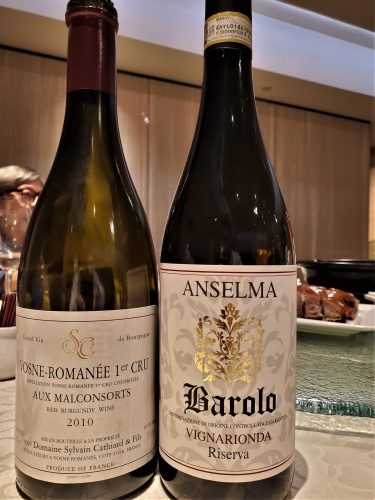 我們姑且可以這麽說:Burgundy 的陽極是 GV,陰極是 CM,而在 VR 則陰陽和合,是個光與影的世界。
我們姑且可以這麽說:Burgundy 的陽極是 GV,陰極是 CM,而在 VR 則陰陽和合,是個光與影的世界。
我選來比較的一雙也很有意思:Aux Malconsorts 位於 Vosne Romanee 的南端,緊挨著雄赳赳的 La Tache,大概因爲土壤有點類似,Allen Meadows 眼中的 Aux Malconsorts 是這樣的:
Aux Malconsorts creates the biggest and most powerful of all the Vosne premiers crus and often the most long-lived.
我們今天選的 Sylvain Cathiard,是被他譽爲這塊田最佳典範的兩家酒莊之一(另一是 Alain Hudelot)。
Clive Coates 幾乎把 Sylvain Cathiard 封聖:
There is a touch of genius here in the winemaking, resulting in bottles of exceptional purity and fragrance: Pinot Noir at its most elegant.
我選來與之比較的不是 Falletto — 他的對應應該是 La Tache,甚至是我猜想中的 Romanee Conti。以前我比較過 Vigna Rionda 與 Falletto,我覺得 Vigna Rionda 像河流,Falletto 如崇山,對陰陽和合的 Vosne Romanee 用外剛内柔的 Vigna Rionda 較爲合適。但我避開新派的 Luigi Pira 與精神上的新派 Massolino 不用,而選了 Giacomo Anselma,因爲除了 Giacosa 以外,我認爲他是最出色的一位。兩年前的一場 Vigna Rionda 比試中,他曾在 Giacosa 以外的 8 家酒莊中脫穎而出,成爲 WOTN(見:VIPa-8 第 10 場 — 尋找 Vigna Rionda 的新伯樂)。所以這一雙從天、地與人的角度都配合得天衣無縫。
第一天晚飯時,5. Sylvain Cathiard, Vosne Romanee 1er Cru Aux Malconsorts, 2010 很有陽光氣,鮮活,有活力,但新鮮的水果與新削出來的橡木在互相唱和,桶太搶了。我常覺得 Burgundy 剛開瓶未接觸太多氧氣時往往會有種含混不清,鼓著悶著,活力不足的感覺,我懷疑那是天氣寒涼,欠缺陽光所導致。2005 和 2010 這些年份卻是例外,像很多意大利酒一樣非常有活力,原因是這些是少有的陽光充沛的年份,眼前的這款 2010 喝起來便很 Italian。
6. Giacomo Anselma, Barolo Vigna Rionda Riserva, 2010 噴著乾花、草本、香料的香氣,酸度好,丹寧不嚴重,當晚是葉。
第二天晚上第一回合,5. Sylvain Cathiard, Vosne Romanee 1er Cru Aux Malconsorts, 2010 使出了渾身解數,香料與果盡出,乾净,銳利得如一束激光,我喝到熾熱的陽光。這時的木桶味被充足的果味包納了,喝起來幾乎像一款現代派 Barolo。
6. Giacomo Anselma, Barolo Vigna Rionda Riserva, 2010 把前一天晚上的各種味道放大了,更濃烈,更圓潤,也更好喝。
第二回合的 5. Sylvain Cathiard, Vosne Romanee 1er Cru Aux Malconsorts, 2010 更上一層樓,木桶已經幾乎天衣無縫的嵌入酒體裏了,剛才的激流剛進入寬敞的河道,頓時變得開闊而通透,徐徐的散發著花、香料與鮮果組成的有層次的香氣,既有活力也優雅,足証 Clive Coates 説得一點都沒錯。
6. Giacomo Anselma, Barolo Vigna Rionda Riserva, 2010 的香氣現在變深變大了,渾厚的黑果與礦物包裹著厚厚的丹寧,但圓潤而一點都不霸道,這是 Vigna Rionda 的語言:和諧而非力量。
Aux Malconsorts 秀麗,Vigna Rionda 圓融,實在難以比高下(除了價格 — 一笑!)。與其他兩雙一樣,要意大利開得差不多一樣好,或許要找一瓶老一點的 — 2004 如何?
可圈可點的是,5. Sylvain Cathiard 到了第二回合才進入狀態。我一年前開的一瓶到第三天最好喝,所以我認爲我們今天所見不過是冰山的一角!
Wine of the Night
其實我有點害怕選 WOTN,因爲上面也解釋過了,同年份的意酒永遠沒有 Burgundy 開得那麽充足,所以沒有可比性。不過權當逰戲,待客也應禮讓三分才是。
結果讓 Burgundy 包辦了頭兩名:
冠軍:3. JF Mugnier, Chambolle Musigny Les Amoureuses Premier Cru, 1998(6 票第一名,加權 20 分)。
亞軍:1. Armand Rousseau, Gevrey Chambertin 1er Cru Clos St Jacques, 2006(2 票第一名,加權 18 分)。
其餘的酒,2. Case Basse Soldera, Brunello di Montalcino Riserva, 2006 與 4. Mascarello Giuseppe, Barolo Monprivato, 1998 各拿 3 票第二或第三名。
兩款 2010 太新了,只有 1-2 票。
以前聼一位台灣的朋友説過,Burgundy 跑短途,而 Barolo 與 Barbaresco 是長途客,這無疑是對的。但要從根源去找原因:意大利有更多陽光,通過葡萄把更多東西塞進酒裏去,要把他打開,自然要更長時間。
正因有此差異,喝不同的酒才有更大樂趣。至於比高低,讓商人去胡謅吧。
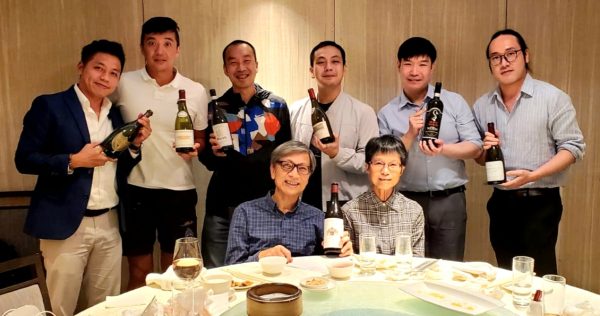
附錄
我為這場鑒賞會寫了我對 Burgundy 的粗淺認識,現附錄於下供參考:
Background, and a super brief guide to Burgundy
My encounter with Burgundy started around 2000, at the same time I was trying out many different regions, until an accident directed me to the Italians. After I met Il Paradiso, I sank deeper into the pit. Now wine is not just wine — it is NATURA, encoded in a juice and locked up in a bottle.
8 years ago, a loyal follower in Guangzhou asked me if she should also learn Burgundy. I could not offer her an answer from my limited experience, so I asked several wine friends for their experience, and I included them in this blog: Burgundy vs Italian(上)
As with the Italians, I could not just take their words for truth. I had to do it myself. So I spent the last 7 years searching for an answer.
Everybody was telling me that Burgundy is different, like: terroir is king, producer is the most important, and Pinot Noir is the most difficult and most beautiful, most faithful to terroir, etc. Yes, because Pinot Noir is so delicate, thou shall not decant it. In fact, open it just 3-1/2 hours before serving (as one expert was telling Dily when she did an event for me years ago).
What I found out is this: at its very essence, all wine is the same. When I entertained my friends with a pair of Burgundy vs Barbaresco, one asked me: do you use a different criterion to evaluate Burgundy? My answer was simple: follow the wine.
I just followed what was taught by Florio Guerrini of Il Paradiso: wine is NATURA. In simpler terms: 天地人.
Of course Burgundy is different, first of all because of 天 — it is grown in a cold region, without much protection from the cold wind from the north. Contrast this with Barolo and Barbaresco, which has the Mediterrean sun for heat and light, and its winter is protected by the Alps in the north, and the Apennines in the south-west protects it from the moisture of the sea.
Burgundy’s weather dictates a grape varietal that is early ripening, and a skin that does not have too much tannins. The Langhe’s weather favors a late ripening varietal, and can ripen a skin with a lot of tannins. The ambassador is appointed by Heaven.
地 – you might think Burgundy is most precious for terroir, but that is only due to Napoleon’s laws of inheritance (which breaks up land property as it passes from generation to generation), and the Middle Age monks who in their loneliness spent time on studying the land and gave names to different plots.
What I found out is however quite different from such hearsay. True, there are distinct changes in soil composition in Burgundy, but this is true in the Langhe (and many wine regions) as well. As for the actual landscape, I would say Burgundy is truly simple – it is just one long south-east facing slope like Cannubi, uniform in height and running through the whole wine region, and the changes along this long slope is gradual and almost predictable — variations due to the mix of limestone, sand/silt and clay. In Barolo however, you have great shifts in both orientation and altitude everywhere you go, and changes in terroir is almost mind boggling. The monks, if they had studied Barolo, would have found the land there to be ten times more difficult to slice up.
I would add one very important fact from my years of experience: Burgundy never opens up well enough with a 3- to 4-hour breathing in the bottle. These days, I treat them exactly the same as the Italians. I have demonstrated this a dozen times to my fellow wine drinkers, and they are convinced.
I don’t have time to explore Burgundy the way I do Italy. To me, reds from only 3 ½ regions are sufficient — these three below (about which I have written 3 blogs), plus Volnay. They are the cream of Burgundy, if you like.
Love in the Time of Coronavirus (3): Gevrey-Chambertin
Love in the Time of Coronavirus (5): Chambolle-Musigny
Love in the Time of Coronavirus (6): Vosne-Romanee